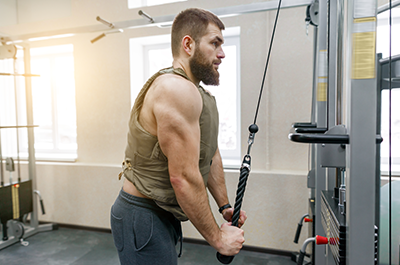You might have heard the term “referred pain,” but maybe you don’t know what it really means. And for good reason; it’s a confusing concept. Referred pain is feeling the sensation of pain in a different location than where you sustained an injury.
While scientists aren’t entirely clear about how and why referred pain occurs, they know it’s caused by some sort of malfunction in the nervous system. “Nerve compression is a common trigger,” says Rebecca Kurtz, an exercise physiologist at Henry Ford Health. It can also arise when pain signaling systems go awry and there’s miscommunication in the area where the nerves meet the spinal cord.
Take a pinched nerve, for example. Even though the damage may be in your spine, the pain can show up further down the chain, such as in the buttocks or legs. Similarly, a pinched nerve in your neck might translate to elbow or shoulder pain.
Athletes in the Crossfire
Athletes often experience referred pain because their muscles are overcompensating for weak areas in the body. A runner may have referred pain from the hip, a swimmer may feel referred pain coming from the neck and a baseball player from the shoulder.
“The referred pain may be due to an acute injury, such as something that happens in a contact sport, or it may be due to an overuse injury acquired from a repetitive motion,” Kurtz says. “So an athlete may feel pain on the outside of his knee, but the pain actually stems from dysfunction at the hip joint – their lateral hip muscles are not as strong as they should be.”
Common Sites
While you can experience referred pain almost anywhere (a heart attack shows up as referred pain in the left shoulder, for example), Kurtz says referred pain commonly occurs in these areas:
- Back pain, which may be felt in the hips, groin, buttocks and thighs
- Groin pain, which may be felt in the abdominal region
- Hip pain, which may show up in the low back
What You Should Know
It’s no surprise that referred pain makes diagnosing injuries difficult. There are many places the pain can show up. Before you can solve referred pain problems, you have to identify the source of injury. If you only treat the location where you feel the pain, you won’t achieve lasting pain relief.
“A biomechanical analysis can help to determine if there are any faulty movement patterns that may be causing your pain and help to identify where the source of the injury,” says Kurtz.
If pain lasts longer than a couple of weeks, the pain is very severe or if you feel any kind of numbness, tingling or weakness in your extremities, pay a visit to a health professional. Once a physician diagnoses the problem, a physical therapist or athletic trainer can help you rehabilitate and identify any biomechanical deficiencies – and show you how to correct them.
If you think you’re suffering from referred pain, visit henryford.com or call 1-800-HENRYFORD (436-7936). For a comprehensive analysis of your fitness and athletic performance, call the Henry Ford Human Performance Clinic at (313) 972-4030.
Rebecca Kurtz is an exercise physiologist who sees patients and athletes at the William Clay Ford Center for Athletic Medicine in Detroit.



